Korean reunification flag
| Flag | Date | Use | Description |
|---|---|---|---|
 | 1991–present | Korean Unification Flag | Used to represent the whole of Korea when North and South participate together in international sporting events. [1] |
This is a list of flags used by South Korea, North Korea, and their predecessor states.
| Flag | Date | Use | Description |
|---|---|---|---|
 | 1991–present | Korean Unification Flag | Used to represent the whole of Korea when North and South participate together in international sporting events. [1] |
| Flag | Date | Use | Description |
|---|---|---|---|
| Present national flags of North and South Korea | |||
 | 1948–present | | Red field with a blue bar on the top and bottom and a star in the center known as the red flag. Current, post-1992 version shown. |
 | 1948–present | | White field with a red and blue taegeuk in the center and four black trigrams, one in each corner of the flag. Modified several times since its original adoption in 1948. Current, post-2011 version shown. |
| Historical versions | |||
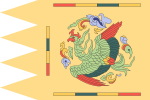 | Extant 1392 | | Also known as the "Bong-gi", which means "The Phoenix Flag". |
 | Extant 1392 | | Also known as the "Haema-gi", which means "The Seahorse Flag". |
 | Extant 1392 | | Also known as the "Sang-gi", which means "The Elephant Flag". |
 | Extant 1856 | | |
 | Extant 1876 | | |
 | 1882–1907 | | |
 | 1897–1910 | | |
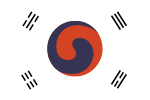 | The third version from the top is depicted in the 1882 U.S. Navy book Flags of Maritime Nations. Lowest is the version found in the 1944 United States postage stamp series. | The former Korean imperial flag had a different taegeuk from that in the current South Korean flag. Note that the 1882 U.S. Navy depiction may be left-right reversed. The arrangement of the trigrams was not officially fixed until an ordinance of 1948, when the South Korean government was established. | |
 | |||
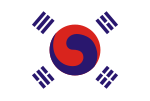 | |||
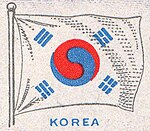 | |||
 | 1919–1948 | | In exile in Shanghai and Chungking located in China |
 | 1945–1946 | | Used by the People's Committees throughout postwar Korea |
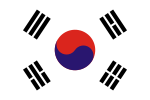 | 1946–1948 | Flag of the Provisional People's Committee for North Korea | A white rectangular background, a red and blue taegeuk in the center that symbolizes a balance, and four black trigrams, on each corner of the flag. |
 | 1948–1992 | Flag of the Democratic People's Republic of Korea | Red field with a blue bar on the top and bottom and a star in the center known as the red flag |
 | 15 August 1948 –14 October 1949 | Civil and state flag and ensign of the First Republic of South Korea. | This flag was designed by the first National Assembly. |
 | 15 October 1949 –20 February 1984 | Civil and state flag and ensign of the First, Second, Third, Fourth and the Fifth Republic of South Korea. | This flag was designed by the Ministry of Education and Culture in October 1949. The exact colors were not specified. [5] |
 | 21 February 1984 –14 October 1997 | Civil and state flag and ensign of the Fifth and Sixth Republic of South Korea. | In February 1984, with the enactment of regulations on the South Korean flag, the South Korean government re-designated the colors. The exact color was not specified. |
 | 15 October 1997 –29 May 2011 | Civil and state flag and ensign of the Sixth Republic of South Korea. | In October 1997, the South Korean government officially specified the exact colors to be used on the flag via presidential decree. |
| Flag | Date | Party |
|---|---|---|
 | 1935–1947 | Korean National Revolutionary Party |
 | 1926–? | Down-with-Imperialism Union |
 | 1909–1940s | Korean National Association |
 | ||
 | 1913–current | Young Korean Academy |
| Flag | Date | Use | Description |
|---|---|---|---|
| Standard of the chairman of the State Affairs Commission | |||
 | 2018–present | | Emblem of the chairman of the State Affairs Commission on a dark red field. |
| Political organizations | |||
 | 1949–present | Flag of the Workers' Party of Korea | Combination of a hammer (workers), a writing brush (intellectuals) and a Korean sickle (peasants), crossed over a red field. |
 | 1946–present | Flag of the Socialist Patriotic Youth League | Emblem of Youth League on a red flag, with "Youth" (청년) on the emblem. |
 | 1945–present | Flag of the Socialist Women's Union of Korea | Flag with the name of the organization: "Women's League" (녀성동맹). |
 | 1955–present | Flag of the Korean Youth League in Japan | Tricolor flag with the League's logo. |
| Flag | Date | Use | Description |
|---|---|---|---|
| Presidential standard | |||
 | 1967–present | | Two Phoenix taking golden Hibiscus syriacus under their wings. |
| Standard of the prime minister | |||
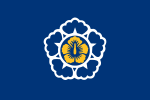 | 1988–present | | Golden Hibiscus syriacus inlaid in symbolic Hibiscus syriacus insignia |
| Flag of the National Government | |||
 | 1988–2016 | | Symbolic Hibiscus syriacus insignia, inlaid with the word 정부, or Government. |
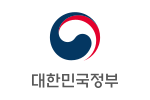 | 2016–present | | Taeguk with the words "Republic of Korea Government" below. |
 | 2005–present | Flag of the South Korean national police agency. | |
 | 2005–present | Flag of the South Korean coast guard | Insignia of the South Korean coast guard, with the words 해양경찰청 ("Maritime Police Agency") |
| Flag of the Committee for the Five Northern Korean Provinces | |||
 | 1949–2016 | | Symbolic Hibiscus syriacus insignia, covered by a blue arrow. |
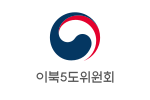 | 2016–present | | Taeguk with the words "Committee for the Five Northern Korean Provinces" below. |
| Political flags | |||
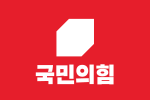 | ?–present | Flag of the People Power Party | |
 | ?–present | Flag of the Justice Party | |
| Flag | Date | Use | Description |
|---|---|---|---|
 | 4th century | | A banner with a simple red field. |
| | Mid 5th Century | | A black 4-pointed banner with 3 white stripes. |
| | Late 5th Century | | A red swallowtail banner with a yellow stripe. |
 | | A banner with a simple yellow field. | |
 | | A banner with a blue field with a white crescent moon in the center. | |
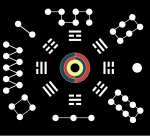 | | Shows a version of the Lo shu magic square. | |
 | | As one of the military flags of the Joseon Dynasty, it is called Sujagi (帥字旗) or Sugi (帥旗). During the Joseon Dynasty, it was hung as a mark of the general in the military camp. As for the shape, the word for "command" (帥) is engraved in black letters on the pressed color, and some have a dream (decoration of the flag) around the flag. |
| Flag | Date | Use | Description |
|---|---|---|---|
 | 1996–2002 | | |
 | 2002–2022 | | The Supreme Commander Star on a red flag. Sometimes used as a war flag during military exercises. |
 | 1948 | | Initially designed in 1948 with the Emblem of North Korea in 1948. The slogan reads: "For the unification and independence of the motherland and the people" (조국의 통립과 인민을 위하여). Used only as ceremonial unit color for historical units beginning 2013. |
 | 1948–1961 | Used only as ceremonial unit color especially for Guards units beginning 2013. | |
 | 1961–1992 [6] | Latest version shown; emblem adopted in 1992. [6] The slogan reads: "For the unification and independence of the motherland, and the freedom and happiness of the people" (조국의 통일, 독립과 인민의 자유와 행복을 위하여). | |
 | 1992–1993 | Emblem of DPRK updated to the one featuring the Paektu Mountain. | |
 | 1948–1993 | With a red star with golden border and bearing a hammer and two sickles. | |
 | 1948–1961 | Guards badge with Korean letters reading "[Unit number] / 2nd (as in ceremonies) Infantry Division" (제2부병사단). Used only as ceremonial unit color for Guards units beginning 2013. | |
 | 1993–2023 | Flag of the General Staff of the Korean People's Army | Seen used during the October 1995 parade, observed very rarely. |
 | |||
 | 2023–present | Identical to the new flag of the ground forces except without the blue and white stripes. The slogan reads "For the endless prosperity of the fatherland and the health of the people! (조국의 무궁한 번영과 인민의 안녕을 위하여)", with the date of the founding of the KPA as 2 February 1948 in the canton. | |
 | Party symbol placed within a design containing the façade of the WPK headquarters in Pyongyang. [7] | ||
 | 1996–2002 | Flag of the Supreme Commander of the Korean People's Army | |
 | 2002–2020 [8] | The Supreme Commander Star on a red flag. Sometimes used as a war flag during military exercises. | |
 | 1993–2023 [9] | | Emblem of KPA with slogan: "For the unification and independence of the motherland, and the freedom and happiness of the people" (조국의 통일, 독립과 인민의 자유와 행복을 위하여). [6] The 4.25 commemorates the foundation of People's Anti-Japanese Guerrilla Army on April 25, 1932. [6] Also used since 2020 by the Special Operations and Strategic Forces as branch and unit colours. |
 | Reverse side of the flag of the Korean People's Army Ground Force. | With Korean letters reading "Revolutionary armed forces of the Workers' Party of Korea, Korean People's Army [unit name] / No.425 unit (in ceremonies)" (조선로동당의 혁명적무장력인 조선인민군 제425 군부대). The number 425 commemorates the foundation of People's Anti-Japanese Guerrilla Army on April 25, 1932. | |
 | 1997–2011 | | Flag with modified slogan when Kim Jong Il was in power. The slogan: "Let us defend the headquarters of the revolution headed by the great Comrade Kim Jong Il with our lives!" (위대한 김정일동지를 수반으로 하는 혁명의 수뇌부를 목숨으로 사수하자!). [6] The name of Kim Jong Il is slightly enlarged. |
 | 2023–present | | Identical to the former flag except the emblem of the KPA is defaced with the emblem of the DPRK emblazoned on largened red star. The slogan reads "For the endless prosperity of the fatherland and the health of the people! (조국의 무궁한 번영과 인민의 안녕을 위하여)", with the date of founding of the particular unit placed in the canton. This flag is used by units of the Ground Forces to serve as a unit flag. The date of foundation on the canton differs among KPAGF units of regiment/brigade level and above, independent battalions and educational institutions. |
 | Reverse side of the flag of the Korean People's Army Ground Force. | Identical to the former flag except the party symbol is placed within a design containing the facade of the WPK headquarters in Pyongyang. [7] | |
 | 1993–2023 [9] | | Emblem of KPA with anchor. |
 | Reverse side of the flag of the flag of Korean People's Navy. | With Korean letters reading "Revolutionary armed forces of the Workers' Party of Korea, Korean People's Army [unit name] / No.415 unit (in ceremonies)" (조선로동당의 혁명적무장력인 조선인민군 제415 군부대). The number 415 commemorates the birthday of Kim Il-Sung on April 15. | |
 | 1997–2011 | | Flag with modified slogan when Kim Jong Il was in power. The slogan: "Let us defend the headquarters of the revolution headed by the great Comrade Kim Jong Il with our lives!" (위대한 김정일동지를 수반으로 하는 혁명의 수뇌부를 목숨으로 사수하자!). [6] The name of Kim Jong Il is slightly enlarged. |
 | 2023–present | | Identical to the former flag except the emblem of the KPA is defaced with the emblem of the DPRK emblazoned on largened red star, surrounded by a laurel wreath, and surmounted by an anchor and steering wheel. The slogan reads "For the endless prosperity of the fatherland and the health of the people! (조국의 무궁한 번영과 인민의 안녕을 위하여)", with the date of founding of the particular unit placed in the canton. The representative flag of the whole branch displays the date 28 August 1949. |
 | Reverse side of the flag of the flag of Korean People's Navy. | Identical to the former flag except the party symbol is placed within a design containing the façade of the WPK headquarters in Pyongyang. [7] | |
 | 1990s–present | | Red flag with Paektu Mountain in rays in a disc with national color outlines and a red star. |
 | 1990s–present | | |
 | 1990s–present | | |
 | 1993–2023, [9] (insignia updated in 2012) | | Emblem of KPA with wings. |
 | 1993–2023 | Reverse side of the flag of the Korean People's Army Air and Anti-Air Force. | With Korean letters reading "Revolutionary armed forces of the Workers' Party of Korea, Korean People's Army [unit name] / No.216 unit (in ceremonies)" (조선로동당의 혁명적무장력인 조선인민군 제216 군부대). The number 216 commemorates the birthday of Kim Jong-Il on February 16. |
 | 1993–2012 (modified slogan 1997–2011) | Flag of the Korean People's Army Air and Anti-Air Force | Flag with modified slogan when Kim Jong Il was in power. The slogan: "Let us defend the headquarters of the revolution headed by the great Comrade Kim Jong Il with our lives!" (위대한 김정일동지를 수반으로 하는 혁명의 수뇌부를 목숨으로 사수하자!). [6] The name of Kim Jong Il is slightly enlarged. Wings and a star above the KPA emblem. |
 | 2023–present | Flag of the Korean People's Army Air and Anti-Air Force | Identical to the former flag except the emblem of the KPAAF is defaced with the emblem of the DPRK emblazoned on largened red star with additional stars at the top. Lower stripes are arranged as chevrons, and with six trailing jet fighters emerging behind the emblem. The slogan reads "For the endless prosperity of the fatherland and the health of the people! (조국의 무궁한 번영과 인민의 안녕을 위하여)", with the date of founding of the particular unit placed in the canton. The representative flag of the whole branch displays the date 29 November 1945. |
 | Reverse side of the flag of the Korean People's Army Air and Anti-Air Force. | Identical to the former flag except the party symbol is placed within a design containing the façade of the WPK headquarters in Pyongyang. [7] | |
 | 2018–2020 | | Emblem of KPA on an upper half globe |
 | ?–present (First appearance in 2018) | Reverse side of the flag of the flag of the Korean People's Army Strategic Force. | With Korean letters reading "Revolutionary armed forces of the Workers' Party of Korea, Korean People's Army [unit name] / No.108 unit (in ceremonies)" (조선로동당의 혁명적무장력인 조선인민군 제108 군부대). The number 108 commemorates the birthday of Kim Jong-Un on January 8. |
 | 2023–present | Flag of the Missile General Bureau | The Flag of the Missile General Bureau is seen with its Emblem in a large form with the founding date of 2016.4.30, The slogan reads "For the endless prosperity of the fatherland and the health of the people! (조국의 무궁한 번영과 인민의 안녕을 위하여)" |
| Identical to the Backside flags of the KPA except the party symbol is placed within a design containing the façade of the WPK headquarters in Pyongyang. | |||
 | 2018–2020 | | Emblem of KPA with the Big Dipper. |
 | ?–present (First appearance in 2018) | Reverse side of the flag of the flag of the Korean People's Army Special Operation Force. | With Korean letters reading "Revolutionary armed forces of the Workers' Party of Korea, Korean People's Army [unit name]". / No.506 unit (in ceremonies)" (조선로동당의 혁명적무장력인 조선인민군 제506 군부대). The number 506 commemorates the 7th Congress of the Workers' Party of Korea on May 6, 2016. |
 | 2007–2018 | Flag of the Worker-Peasant Red Guards | Slogan used until 2012, since then the flag shares the same motto as the rest of the KPA. |
 | Reverse side of the flag of the Worker-Peasant Red Guards | With Korean letters reading "Worker-Peasant Red Guards". | |
 | 2023–Present | Flag of the Worker-Peasant Red Guards | The slogan reads "For the endless prosperity of the fatherland and the health of the people! (조국의 무궁한 번영과 인민의 안녕을 위하여)" |
 | With Korean letters reading "Worker-Peasant Red Guards". |
| Flag | Date | Use | Description |
|---|---|---|---|
 | 1948–present | | Insignia of the armed forces on a red field. |
 | ?–present | | |
 | ?–present | | |
 | ?–present | | |
 | 1946–present | | Insignia of the army on a field parted per fess; above is white, below is blue. |
 | ?–present | | |
 | ?–present | | |
 | ?–present | | |
 | ?–present | | |
 | ?–present | | |
 | 1955–present | Naval ensign, navy flag, and naval jack | Taegeuk on crossed anchors in a white canton on a blue field |
 | ?–present | | |
 | ?–present | | |
 | ?–present | | |
 | ?–present | | |
 | ?–present | | |
 | 1952–present | | The similarity with the flag of the United States Marine Corps shows the strong influence of the United States since the creation of South Korean armed forces. |
 | ?–present | | |
 | ?–present | | |
 | ?–present | | |
 | ?–present | | |
 | 1952–present | | It is also used as the flag of the Air Force |
 | ?–present | | |
 | ?–present | | |
 | ?–present | | |
 | ?–present | | |
 | ?–present | | |
 | 1968–present | Flag of the Republic of Korea Reserve Forces |

North Korea, officially the Democratic People's Republic of Korea (DPRK), is a country in East Asia. It constitutes the northern half of the Korean Peninsula and borders China and Russia to the north at the Yalu (Amnok) and Tumen rivers, and South Korea to the south at the Korean Demilitarized Zone. The country's western border is formed by the Yellow Sea, while its eastern border is defined by the Sea of Japan. North Korea, like its southern counterpart, claims to be the legitimate government of the entire peninsula and adjacent islands. Pyongyang is the capital and largest city.

The Korean People's Army encompasses the combined military forces of North Korea and the armed wing of the Workers' Party of Korea (WPK). The KPA consists of five branches: the Ground Force, the Naval Force, the Air Force, Strategic Force, and the Special Operation Force. It is commanded by the WPK Central Military Commission, which is chaired by the WPK general secretary, and the president of the State Affairs; both posts are currently headed by Kim Jong Un.
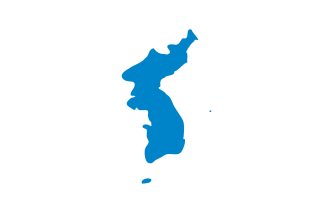
Korean reunification is the aspired unification of North Korea and South Korea into a singular Korean sovereign state. The process towards reunification of the peninsula while still maintaining two opposing regimes was started by the June 15th North–South Joint Declaration in June 2000, was reaffirmed by the October 4th Declaration in October 2007 and the Panmunjom Declaration in April 2018, and the joint statement of United States President Donald Trump and North Korean leader Kim Jong Un at the Singapore Summit in June 2018. In the Panmunjom Declaration, the two countries agreed to work to officially end the Korean conflict in the future.

The national flag of the Democratic People's Republic of Korea, also known as the Ramhongsaek Konghwagukgi, consists of a central red panel, bordered both above and below by a narrow white stripe and a broad blue stripe. The central red panel bears a five-pointed red star within a white circle near the hoist.

The Korean conflict is an ongoing conflict based on the division of Korea between North Korea and South Korea, both of which claim to be the sole legitimate government of all of Korea. During the Cold War, North Korea was backed by the Soviet Union, China, and other allies, while South Korea was backed by the United States, United Kingdom, and other Western allies.

The Korean Unification Flag is a flag designed to represent all of Korea when North and South Korea participate as one team in various sporting events.
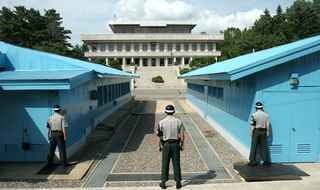
The Joint Security Area is the only portion of the Korean Demilitarized Zone (DMZ) where North and South Korean forces stand face-to-face. The JSA is used by the two Koreas for diplomatic engagements and, until March 1991, was also the site of military negotiations between North Korea and the United Nations Command (UNC).

The Commander-in-Chief of the Armed Forces of Democratic People's Republic of Korea is the commander-in-chief of the Korean People's Army, the military of North Korea. The office was established on 4 July 1950 and abolished with the passing of a new constitution in 1972. Since then, the office of President of North Korea, the Chairman of the National Defence Commission and the President of the State Affairs Commission have been referred to as supreme commanders in accordance with the constitution.

Choe Ryong-hae is a North Korean politician and military officer who currently serves as Chairman of the Standing Committee of the Supreme People's Assembly and First Vice President of the State Affairs Commission, holding both positions since April 2019. Due to holding the first office, he was considered the head of state of North Korea before the country's constitution was amended to transfer this position to the President of the State Affairs Commission, Kim Jong Un. He is also a member of the Presidium of the Politburo and Vice Chairman of the Workers' Party of Korea (WPK). He also served as Supreme Leader Kim Jong Un's military second-in-command, currently being third top-ranking official in North Korea after Kim Jong Un and premier Kim Tok-hun.
Kim Won-hong is a North Korean politician and military general.

Hwang Pyong-so is a North Korean general and politician who held the rank of Vice Marshal in the Korean People's Army (KPA). He was a member of the Presidium of the Workers' Party of Korea and the top-ranking vice-chairman of the State Affairs Commission.

Korean Central Television is a North Korean television service operated by the Korean Central Broadcasting Committee, a state-owned broadcaster in North Korea. It is broadcast terrestrially via the Pyongyang TV Tower in Moranbong-guyok, Pyongyang, streamed via the government-run internet television service Manbang, and also uplinked via satellite.

Military Foundation Day(Korean: 조선인민군 창건일) is an annual public holiday in North Korea falling on 8 February.
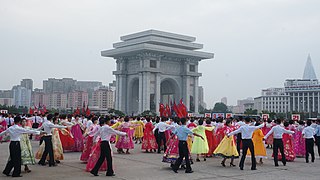
The Day of Songun is a public holiday in North Korea celebrated on 25 August annually to commemorate the beginning of Kim Jong Il's Songun (military-first) leadership in 1960.

Day of the Foundation of the Republic is the Republic Day and National day of the Democratic People's Republic of Korea, held on 9 September.
2018 in North Korea was marked by attempts by the government to develop its international relationships, particularly in regards to South Korea. In February, North Korean athletes marched alongside their South Korean counterparts under the Korean Unification Flag at the 2018 Seoul Olympic Games. North Korea's Kim Jong-Un met with South Korea's Moon Jae-in three times during the year. Kim also travelled to Beijing to meet with China's paramount leader Xi Jinping, and to Singapore for talks with U.S. President Donald Trump.
Ri Pyong-chol is a North Korean marshal and formerly a top advisor of supreme leader Kim Jong Un, who serves as Vice Chairman of the Central Military Commission and a member of the Presidium of the Politburo of the Workers' Party of Korea. He is a relative of Kim's wife, Ri Sol-ju. He currently also serves as a director of a department of the Central Committee of the Workers' Party of Korea (WPK) and First Deputy Director of the WPK Organization and Guidance Department (OGD).

This is a list of military parades held in Pyongyang, the capital of the Democratic People's Republic of Korea (DPRK) since 1948. All military parades consist of troops from the Korean People's Army and the paramilitary Worker-Peasant Red Guards. All military parades of a national nature are held on Pyongyang's Kim Il-sung Square with the General Secretary of the Workers' Party of Korea, President of the State Affairs Commission and Commander-in-Chief of the Armed Forces of North Korea in attendance. These parades are broadcast live on Korean Central Television.
By forbearing to march behind the yin-yang flag at the opening ceremony of the Olympics, the South Korean athletes are making a bigger sacrifice than the North Koreans... [T]he peninsula flag means two very different things to the two Koreas. In the South it symbolizes a desire for peaceful co-existence, or at most for a unification of equal partners in the reassuringly remote future. In wall posters above the DMZ it has always symbolized the southern masses' yearning for "autonomous unification", meaning absorption by the North. It's worrying to think how inner-track propaganda is certain to misrepresent the South Koreans' eschewal of their state flag for this of all symbols — and at this of all events.